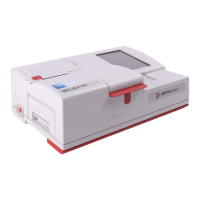Operator’s Manual – OPTI CCA-TS2 pH-B-1
ANALYTES pH (Dry Sensor)
pH (Dry Sensor - B-Lac Cassette)
Clinical Signicance
1
The pH value of the blood, serum or plasma may be the single most valuable factor in the evaluation of
the acid-base status of a patient. The pH value is an indicator of the balance between the buffer (blood),
renal (kidney) and respiratory (lung) systems, and one of the most tightly controlled parameters in the
body. The causes of abnormal blood pH values are generally classied as:
a) primary bicarbonate decit - metabolic acidosis
b) primary bicarbonate excess - metabolic alkalosis
c) primary hypoventilation - respiratory acidosis
d) primary hyperventilation - respiratory alkalosis
An increase in blood, serum or plasma pH (alkalemia) may be due to increased plasma bicarbonate,
or a feature of respiratory alkalosis due to an increased elimination of CO
2
, due to hyperventilation.
A decreased pH value (acidemia) in blood, serum or plasma may occur due to an increased formation
of organic acids, an increased excretion of H
+
ions in certain renal disorders, an increased acid intake
such as in salicylate poisoning or loss of alkaline body uids. Respiratory acidosis is the result of a
decreased alveolar ventilation and may be acute; as the result of pulmonary edema, airway obstruction or
medication, or may be chronic; as the result of obstructive or restrictive respiratory diseases.
Measurement Principle
The pH optode measurement principle is based upon pH-dependent changes of the luminescence of a dye
molecule immobilized in the optode. Such pH indicator dyes have been used by chemists for many years
to perform acid-base titration in turbid media.
The relationship of luminescence to pH is quantied by a variant of the Mass-Action Law of chemistry,
which describes how the uorescence emission intensity of the dry pH sensor decreases as the blood pH
is increased above the dye’s characteristic pKa.
R is the ratio of minimum uorescent intensity (pH >> pKa) to maximum uorescent intensity (pH
<< pKa). pH optodes do not need a reference electrode to measure pH, however, they exhibit a small
sensitivity to the ionic strength of the sample being measured
2
.
Measurement Range
Range Resolution (Low/High) Units
6.6 to 7.8 0.01/0.001 pH units

